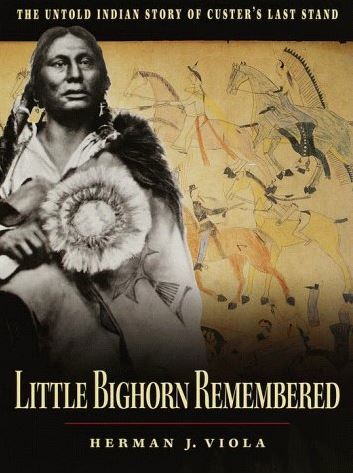On the morning of June 25, 1876, soldiers of the elite U.S. Seventh Cavalry led by Lieutenant Colonel George Armstrong Custer attacked a large Indian encampment on the banks of the Little Bighorn River. By day’s end, Custer and more than two hundred of his men lay dead. It was a shocking defeat–or magnificent victory, depending on your point of view–and more than a century later it is still the object of controversy, debate, and fascination.
What really happened on that fateful day? Now, thanks to the work of Herman J. Viola, Curator Emeritus of the Smithsonian Institution, we are much closer to answering that question. Dr. Viola, a leader in the preservation of Native American culture and history, has collected here dozens of dramatic, never-before-published accounts by Indians who participated in the battle–accounts that have been handed down to the present day, often secretly and accompanied by oaths of silence, from one generation to the next. These remarkable eyewitness recollections provide a direct link to that day’s events; together they constitute an unprecedented oral history of the battle from the Native American point of view and the most comprehensive eyewitness description of Little Bighorn we have ever had.
Here are the dramatic stories of the Cheyenne and Lakota warriors who rode into battle against Custer, the yellow-haired Son of the Morning Star, an adversary whose valor they admired–but who became a mortal enemy after breaking his peace-pipe oath, a scene described vividly in these pages. Here in their own words are the stories of the Crow scouts, allies of Custer, who advised against attacking Sitting Bull’s village on the Little Bighorn. Here are tales of valor told by the Arikara scouts who fought side by side with Custer’s men against the Lakota and Cheyenne; although the Great Father in Washington rewarded their heroism with silence, it is celebrated to this day in tribal stories and songs that come to us from beyond the grave with hair-raising immediacy and power.
Lavishly illustrated with more than two hundred maps, photographs, reproductions, and drawings, this remarkable book also includes:
An account of the battle, including startling descriptions of Custer’s conduct, collected from the Crow scouts by the famed photographer Edward S. Curtis in 1908. Curtis never published this report–President Theodore Roosevelt advised him not to–and it remained a secret until his ninety-year-old son recently gave the material to the Smithsonian.
New archaeological evidence from the battlefield that casts fresh light on the Seventh Cavalry’s movements, along with discoveries from the site of Sitting Bull’s village–including the complete skeleton of a cavalry horse with its rider’s well-
preserved saddlebags and personal items.
A series of illustrations made soon after the battle by Red Horse, a remarkable tableau that is reproduced here in its entirety for the first time.
Three letters written by Lieutenant William Van Wyck Reily just days before he died at Little Bighorn that provide key and potentially controversial insights into the conduct of the cavalry under Custer’s command.
In short, this landmark book takes us much closer to knowing what really happened on that June day in 1876 when Custer died and a legend was born.

